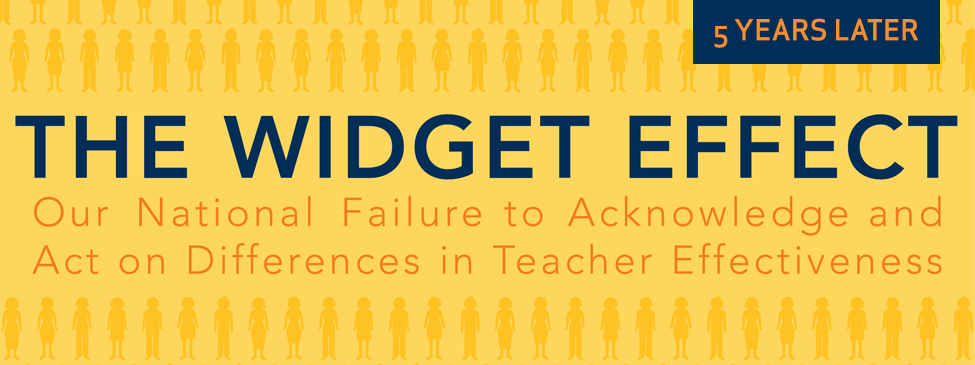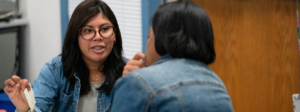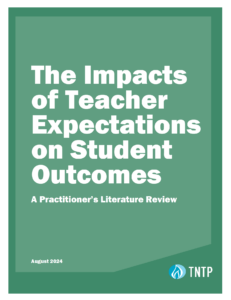As we consider the progress that’s been made with teacher evaluation in the last few years—and the challenges that remain—we sat down with three school leaders to better understand what it’s like to implement evaluation at the school level.
Ryan Bennett is the co-director of Arthur Ashe Charter School, part of the FirstLine Schools network in New Orleans. Hafedh Azaiez is the principal at Paul Revere Middle School, and Juan Gonzalez is the principal at Patterson Elementary School, both in the Houston Independent School District.
Tell me a little bit about the evaluation process at your school. How does it look and feel different from what you’ve done in the past?
Ryan Bennett: Where things feel different is that our teachers receive weekly coaching. I call it “coaching” because our evaluation process isn’t just about observation and feedback—that implies a singular direction, highlighting problems that need to be fixed—rather than supporting teachers to do things differently. Our system aims to not only illuminate what’s happening in the classroom, but to really equip teachers with the power to change their own practice.
Hafedh Azaiez: The bare minimum—mandated by the district—for our evaluation process is that each semester, each teacher gets one 10-minute walk-through and a 30-minute observation, and then receives feedback. But the reality is that we’re in their classrooms much more regularly. I’m the instructional leader of this campus—that’s my most important role. If I’m not in the classroom, giving feedback, every day, then I’m not doing my job. With the current evaluation rubric, when we go into a classroom, we have a set of concrete things we’re looking for. What role are the teachers playing in the classroom? Is the instruction student-centered? Are the teachers differentiating? Are they engaging students’ higher order thinking skills?
Juan Gonzalez: Beyond the formal walk-through and observation each semester, I’m giving informal feedback constantly. If I’m in a classroom for just two or three minutes, I might send an email with something specific that is positive and any specific, quick concerns. Or I’ll leave a note for the teacher. If there’s a longer conversation that needs to be had, we’ll sit down to talk through what I saw.
What’s working well so far?
HA: What I like about the new system is that it’s very straightforward. Previously, we didn’t have a clear rubric for the kinds of practices we were looking for. It was harder for teachers to understand what their goals were and how to get there. The rubric makes it easier for all of us to understand what we’re aiming for.
RB: The frequency of the coaching is key for teachers to really hold onto the feedback and put it into practice. When the teacher/coach touchpoints are more spread out—say, every few months—and we try to jam a lot of stuff into that conversation, what sticks is much less than what I see sticking now, with more regular touchpoints and smaller individual goals.
I think the evaluation process also has the opportunity to ground teachers in what they’re doing well—if the coaching meetings are structured well. It’s important that in addition to communicating areas for improvement, we also help teachers recognize what they have in their toolkits that they should hold onto. We tend to sometimes throw the baby out with the bathwater when we change things. Coaches have the chance to identify things teachers should continue doing, while giving them small things to focus on every day.
How have teachers reacted to the evaluation process at your school? Are you seeing changes in teachers’ practices as a result?
JG: I see the most change in the teachers who are most open to feedback. The more effective teachers are sometimes less receptive, in fact—because they’ve been more used to doing well and they’re not necessarily open to receiving critical feedback. I’ve seen that new or struggling teachers seem to really accept that they need more support and they find the process useful. A lot of it depends on the teacher’s receptiveness, but I would say I’ve seen about 70 to 80 percent of the teachers in my school learn from the process and improve specific areas of their practice.
HA: We have a very high-performing group of teachers—that’s evident not just in their observation scores, but in their student growth scores as well. But with the evaluation process as it stands, our teachers who are rated effective, for example, can come to us and say, I want to be highly effective. How do I get there? And together, we can look at the rubric. The rubric allows for a lot of transparency, and it’s enabled our teachers to set specific goals for themselves and push themselves further.
What kinds of strategies did you use to bring everyone on board with the new system?
HA: In Houston, a committee of teachers was able to give input into the design of the evaluation system—what factors should be included, what should be modified, etc. That has helped. But I think my relationships with the teachers at my school are the most important part of getting them on board with this process. We’re here to support them and help them get better. This system is not intended to fire people—it’s intended to reward great teachers and help teachers in need of improvement to get better. So I think it’s very important that we have a culture of trust at our school to start from.
RB: We’ve moved to a new rubric this year—the state of Louisiana uses COMPASS, but we are now using our own modified version of the TNTP Core Rubric, and the state translates our scores to COMPASS. We’ve really thought through how we communicate about the new rubric to our staff, and prepare teachers for it. It’s a bit more rigorous than our old rubric, so I think our teachers’ scores are going to decline. We had our coaching team use videos to practice scoring teachers, and we showed teachers these videos too, so they would feel good about getting, say, a 3 out of 5 on the new rubric. They can see for themselves that the expectations are higher.
We’ve also moved to a career pathways model, based on the evaluation tool, which translates to teachers’ compensation. This is absolutely the right direction to go in—but it does put more weight and importance on getting the evaluation process right and making sure teachers trust it. Time spent on getting leaders normed and teachers up to speed with the new system is really important.
JG: This year, our district created videos to demonstrate the different levels of teacher effectiveness. That’s been helpful to clarify things—in the past, teachers sometimes wondered what we were aiming for, what they were even being evaluated on. Now the criteria are much clearer. There are no surprises.
What have some of the most unexpected or toughest challenges been?
RB: The system is far from perfect. Where we’ve made the most progress is creating the capacity to be able to coach and develop our teachers. To do that, we’ve hired and trained a cadre of middle level leaders—we have eight people coaching in a school with about 50 teachers. Developing these folks to make sure they’re equipped to do this well is a process. Right now, I think our teachers are getting solid feedback focused on important things and they’re getting the opportunity to practice those things, but I think there’s room to make sure the feedback is more effective and targeted to what different teachers need at given moments.
What we expect from our teachers is pretty tremendous, and what they rise to do every day is pretty amazing. There’s a tricky balance between giving them areas to grow in, and just giving them the space to get things done. As we move to the Common Core, every teacher is asked to reevaluate everything they’ve ever done—even our most experienced teachers. How do we hold our teachers to really rigorous standards, but also make sure that the time we spend with them isn’t just one more thing they have to do, but leaves them with something concrete they can do differently tomorrow? In other words, how can we take some of the burden off them tomorrow?
JG: It’s been a challenge—but really important—to build the relationships we need to make the process work well. I’m trying to get my leadership team to build trusting relationships with our teachers so they feel we’re here to help them get better. We want the teachers to tell us what’s happening—what are your goals? How can I help you get better? I think most teachers do feel that that’s what we’re here for, and if they do, they’ll be more receptive to the process. That’s been true in my experience. I think it’s worth the time it takes—but it does take a lot of time to do this well.
Any final thoughts for other school leaders who are working to put stronger evaluation processes in place at their schools?
JG: It’s really important to calibrate observers—at my school, we all go into a classroom at the same time and look at the same things, so we’re on the same page about ratings. That way, if teachers have concerns about their ratings, we can make sure no one is off in left field. I’m coaching the other administrators to make sure we’re all consistent. We calibrate at every grade level, up front, so there are no questions about what we’re looking for.
RB: We can be more detailed and realistic about how much time this really takes. I think we tend to think coaching and developing people takes a huge amount of time—that if I have ten teachers to coach, it’s going to take me all week, and it’s going to be impossible. When you get down to it, you can do a lot with 45 minutes to an hour per person. Let’s be conservative on time for a moment and say a school leader only works 50 hours a week—that’s still just one fourth or fifth of your time. So that’s manageable.
I also think a lot of new teachers have too many hands in the pot. For example, a Teach For America corps member at my school has a coach at school, a manager at TFA, a certification partner, and sometimes that partner also has a coach. One teacher could be getting up to four different sets of directions. So we need to be developing this net of support, sure, but sometimes it can be overwhelming and either stunt a teacher’s growth or frustrate them so they leave the profession. We need to start thinking creatively about how we use different development models in different situations or different school environments to meet teachers’ different needs.







